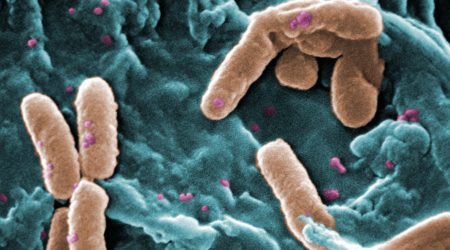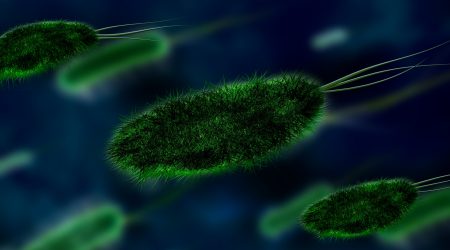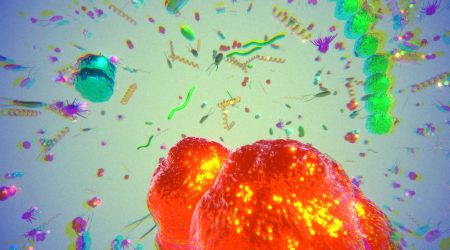The farming methods we have been using for the past century to supply essential nutrients are no longer working. In fact, they are making things even worse...
Elements such as phosphate and nitrogen are essential nutrients in our foods. We use them to build proteins and sustain a wide range of bodily functions – and we get them from plants.
Dr Myriam Charpentier’s group at the John Innes Centre is exploring root endosymbiosis, the mutual relationships between plants, bacteria and fungi that give some plants the ability to supply themselves with nutrients. The aim? To be able to supply our crops with essential elements in a clean, green, natural way.
On Earth, there is no shortage of nitrogen: in its most common form as an inert gas, it makes up 78 per cent of our atmosphere. Unfortunately, animals and plants cannot directly access this element from the air. Phosphate is less abundant than nitrogen but is still mostly inaccessible. It occurs as rock phosphate, a finite resource that needs to be dissolved in water to be accessible to plants and animals.
In agriculture, the widely used solution to this nutrient availability problem is to provide these abundant, yet inaccessible elements as inorganic fertilisers, applying them directly to the soil to make them available to the plant’s root system. This approach has sustained food production since the mid-20th century. The energy required to produce fertiliser makes up about two per cent of all the energy we use on earth. That is a staggering amount.
Adding to this impact, only 40 per cent of the fertilisers that we apply are absorbed by the plants they are aimed at. The remaining nutrients leech into surrounding soil, or run off into rivers and other natural habitats leading to toxic environmental effects and low water quality. In extreme circumstances, this results in dead zones, 880 of which have been identified across the planet. Nitrogen fertiliser is also a source of nitrous oxide, which causes six per cent of human-induced warming.
“More than 50 million tonnes of nitrogen fertiliser are sprayed on to our crops each year, and this leads to pollution and loss of diversity both in the soil and in aquatic systems. We cannot go on like this. We urgently need to minimise the detrimental effect on ecosystems while ensuring sustainable food production,” says Dr Charpentier.
The positive news is that there are naturally occurring phenomena called root endosymbioses, which may help to provide a solution. These ancient associations can be enhanced to reduce our reliance on damaging chemical inputs. Root endosymbioses typically involve two types of interaction between different organisms: an example is between nitrogen-fixing bacteria and plants. These spectacularly useful bacteria have the capacity to fix atmospheric nitrogen into an accessible form when housed in the root nodules of the plant. This type of mutually beneficial relationship is called a root nodule symbiosis.
Legumes, a large family of plants that includes peas, lentils, beans and soybeans, have mastered the art of symbiotic nitrogen fixation. This soil-bound inter-species relationship provides nitrogen directly to legume crops, but also provides enough nitrogen to feed the crops that follow as part of a rotation system.
The other endosymbiotic relationship involves arbuscular mycorrhizal fungi, which enter a mutual relationship with plant roots at a cellular level. This also increases the surface area of the root, and the fungi supply solubilised rock phosphate in return for carbohydrates provided by the host.
The Charpentier group is working on ways in which crops can more effectively establish relationships with these beneficial microorganisms. A complicating factor, however, is that the use of fertiliser has acted as a barrier to these beneficial associations because it degrades the soil environment in which they flourish.
Dr Charpentier explains: “There is a vicious cycle. To produce our food, we use fertiliser, which pollutes the planet and pollutes the soil, which, in turn, limits the endosymbiosis that could do the job of the fertiliser.“We need to provide solutions for the farmer whereby we can increase endosymbiotic association by enhancing the features of the plants that have it. But we must look at promoting endosymbiotic associations under detrimental conditions – and that is what we are interested in in my lab.”
In the longer term, researchers are also working on ways of developing the capacity for nitrogen fixation in staple crops such as maize, wheat and rice, which currently are not able to fix their own nitrogen and rely on chemicals added to the soil.
But the more deliverable goal, potentially in the next five years, is to use genome editing to enhance the capacity of crops to naturally take up nutrients, particularly in detrimental conditions where fertilisers are also used.
Dr Charpentier adds: “The whole aim is to protect the planet by farming in a better, more ecological way. I cannot expect farmers to stop using fertilisers without giving them an alternative solution such as plants which need less fertiliser to obtain the same yield. This will be a solution that ensures fair economic returns for farmers and food consumption that is sustainable on health and environmental grounds.”
These discoveries in fundamental symbiotic relationships are important for crop resilience. In a future where conditions are likely to be more stressful for plants, enhancing the processes that allow crops to adapt and survive are vitally important for sustainable agriculture.
What is endosymbiosis?
Endosymbiosis is a beneficial mutual association of two different organisms where one exists inside the other.
Two examples of endosymbiosis are plants and nitrogen-fixing bacteria, and plants and arbuscular mycorrhizal fungi.
Arbuscular mycorrhizal fungi grow within the root cells of the plant where nutrient exchange takes place – the fungi providing phosphates among other nutrients in return from sugars from the plant.
It is thought that 80 per cent of land plants can benefit from mycorrhizal arbuscular fungi association – enhancing these associations will be key to making crops less dependent on fertilisers.
Legumes are a broad family of land plants that enter into an association with nitrogen-fixing bacteria and fix 22 million tonnes of nitrogen per year. In the roots of legumes, nitrogen-fixing bacteria integrate into the plant root system and within nodules act as nitrogen-fixing micro factories.





